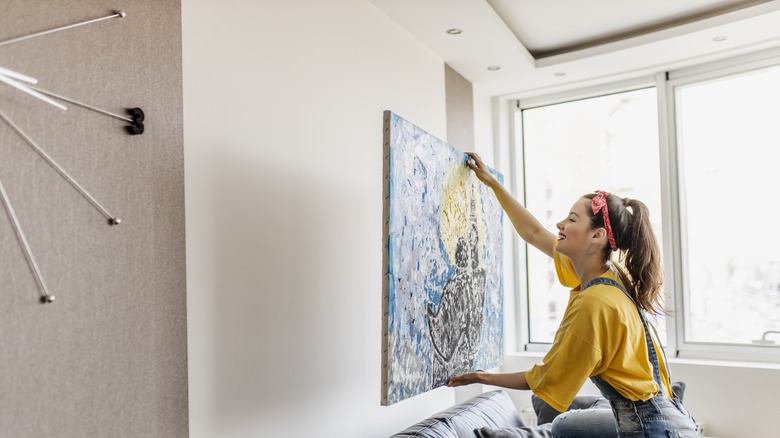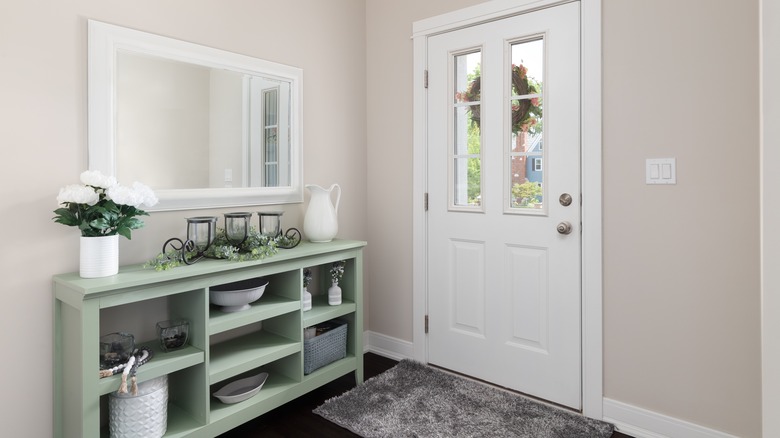Practical Decorating 101: How To Know When Decorations Aren't Right For Your Home
Staring at a space in your home that needs new decor is like gazing at a blank canvas: the possibilities are endless. A table here, a new painting there — no matter the size of the area, there are so many clever ways to create an engaging ambiance when it comes to kitting out a new home or redecorating your current dwelling. However, there is one big mood killer when it comes to interior design: an overabundance of decor that verges on clutter. Sometimes, a well-intentioned setup can turn into a busy, chaotic corner or room, losing sight of your well-intentioned plan among furniture, knick-knacks, and even wall decor. Gearing up to accessorize and fill your dwelling is exciting, but living with an empty area before adding decor can help determine your habits within that space, showing what you need vs. what you just want.
The key to really figuring out what will fit in a room, hallway, nook, or even throughout the entire house is to exist within those areas and watch how you interact with them. If you're re-arranging your entryway, notice where shoes collect, where jackets are thrown or hung, and where outdoor items accumulate. In a bedroom or living room, note where people gravitate toward and what areas look cluttered with just a few items already there. Always try to declutter your home as much as possible, too, before decorating, so you know whether a picture frame might feel too top-heavy on an already busy wall.
Habits determine your space's potential
Decorating shouldn't be rushed, and often impulse buys can result in a busy, over-cluttered look if you don't have a plan. Whether you're starting fresh or just need a revamp, the most exciting part is going to the store and collecting ideas of all the pieces you want to buy to fill a certain space. Sometimes, what looks great on a shelf might not fit your actual layout, and once you try to add too much or over-arrange, clutter ensues. Finding a large cabinet that would match your interior and hold a lot of loose items sounds like the ideal fit for an entryway or bedroom, but if you aren't using the area where this would go a lot or can't afford to sacrifice the floor space, this decor might not be right for your current needs.
Rather than jumping into buying that new hallway bench or armoire for the guest bedroom, allow the space to sit empty (or at least as minimally filled as possible) and interact with it on a daily basis for 3 or 4 days. Watch where certain items go when you need to set them down, or where you tend to gravitate toward, then plan around those areas. Perhaps the hallway needs a shoe-hiding cabinet that is slim enough to leave floor space, too. Maybe a bench will provide storage as well as a flat surface to place items on while people hang their coats in a closet.
Decor shouldn't take away from your aesthetic, it should enhance it
Shopping with intention and practicing patience when it comes to decorating will ensure your home looks welcoming and tidy. Once you've discovered what you do within a certain section of your home, you can go to the store and seek out something that will not only fit, but provide functionality that also keeps clutter at bay. Finishing your home all in one go shouldn't be the endgame: if anything, this can overwhelm and take away from the process of understanding your needs within the dwelling. Even if you've lived in your home for years, it can take days, weeks, months, and years to figure out how you want to utilize a room or area. Embrace this, testing different pieces over time and removing anything that only contributes to built-up clutter. Decor shouldn't overwhelm you, it should enhance your home.
It's fine to have an empty section in your home for a longer period than you intended. By monitoring your habits and interactions with it, you will be more tuned in to what you need from it and how to deliver that. More storage, less storage, bigger pieces, a rug: all of these should provide functionality as well as aesthetics so that you can engage with the space practically and enjoyably. Don't just fill to fill: if a piece of decor makes an area seem busy or takes up precious negative space (which all homes need) then try relocating or downsizing. Never be afraid to wait for inspiration and functionality to help you — it's better to be sure so you're happy with the finished results!

